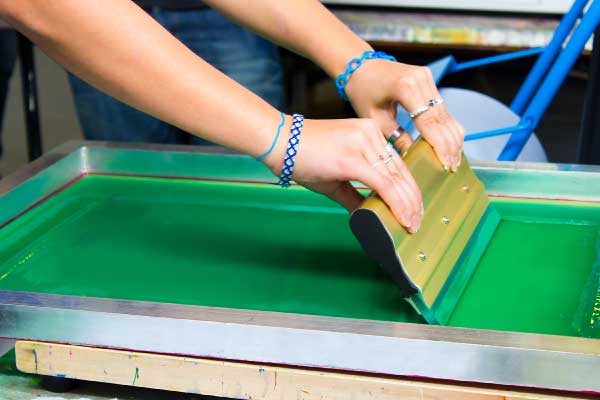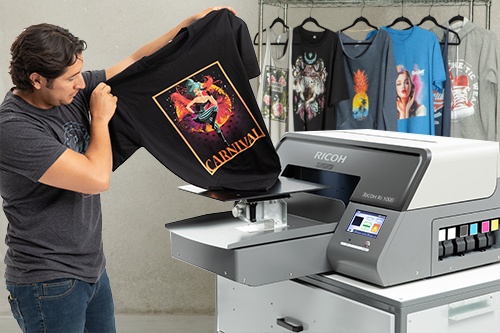

Posted by AllDayShirts on to Printing Techniques.
In the t-shirt printing universe, Direct to Garment printing (We will refer to it as DTG from here on out) has this kind of mystic aura to it. It’s constantly overlooked because of the hefty price tag associated with it, and somewhat deservedly so, DTG can be exponentially more expensive to start up compared to other more affordable t-shirt printing options such as Sublimation or Screen Printing.
However, as an unfortunate result, many t-shirt printers never really learn how DTG works and where it excels compared to other t-shirt printing methods. Right now you could easily be shortchanging yourself by settling for a more familiar cotton t-shirt printing option such as Screen Printing.
Lucky for you, we’re here to help. We’re going to map out exactly when you should be using DTG over Screen Printing. We’re also going to provide some background information for each printing method so you have a general idea of how each one works when we lay out when to use one or the other.
Also as a quick note, the reason why we chose to compare DTG to Screen Printing is that Screen Printing is the most comparable alternative to DTG. This makes it harder to choose between the two. For example, it wouldn't make sense to compare DTG to Sublimation as DTG only works well on cotton while Sublimation only works well with polyester. It’s very clear when to use one or the other.
Screen Printing, on the other hand, can work on cotton and has a similar print quality to DTG. This makes their differences less obvious which is why we’re here to clarify them for you.
Anyways, enough of the jibber-jabber. The long-awaited DTG versus Screen printing ladies and gentlemen!
Before we dive deep into who should be using DTG and who should be using Screen Printing, we need you to understand how both work. We’ll start with Screen Printing.

Screen Printing is the original staple in the t-shirt printing world. It’s been around much longer compared to more recent printing methods like Sublimation and DTG and has continued to stick around for good reason.
The way Screen Printing works is similar to how it sounds. Simply put, ink is pushed through screens and printed onto the surface of the shirt. These are very special screens however, usually made of polyester and can be treated in a particular manner to allow ink to only pass through in very specific parts.
These ‘very specific parts’, make up the design you printed onto it. Once the screen is prepared it’s laid flat on top of the t-shirt and is ready to go for printing. In the printing process, ink is laid on top of the screen and pushed through with a squeegee. If there are multiple colors in the design, this step must be repeated for each color as well as an individual screen must be prepared for each color. This is one of the major drawbacks of Screen Printing.
Once the ink is laid on top of the surface of the shirt it’s usually heated to allow the ink to dry quickly. The result is a very vibrant as well as textured design on the surface of the shirt. This textured feel is one of the most sought after features of Screen Printing.

Source: dtgconnection.com
Direct to Garment is the new kid on the block in the t-shirt printing world. On the outside, it’s not too enticing with the high price tag but it does have its niche in the t-shirt industry.
It works just like a paper printer except you’re printing the design on a t-shirt instead. You simply just connect your computer to whatever DTG printer you’re using and after creating the design with compatible software, you print out the shirt. You normally have to apply a quick pre-treatment to the shirt and speed up the cure with a heat press afterwards, however, the prep is very quick and easy.
DTG designs have a shiny look and feel that add vibrancy to the complex designs that DTG is capable of producing. If you invest in a cheaper DTG printer that goes for around $5,000, you’re sacrificing a lot of production speed. It can take several minutes to print a design with printers like these.
If you invest in a printer like the Epson F2100 which is closer to $15,000, the speed is incredible and can take just a couple of minutes for even some of the most complex designs. These printers do require a decent bit of maintenance however and primarily work on just cotton.
Okay, so now that you’re well versed in the languages of DTG and Screen Printing it’s time to answer the million-dollar question.
When should I use DTG over Screen Printing?
DTG should be used over Screen Printing if you are receiving a high volume of orders (enough to make back the likely at minimum $15,000 investment for the printer in a reasonable time) AND the orders are relatively small. You would also want to use DTG instead if you are getting a lot of orders with complicated multi-color designs.
Let me give an example. Printful, a humungous t-shirt printing company, uses DTG printing. This is because people who order from them tend to have more complicated designs with a lot of colors. Not only that, but a lot of orders are also just for a relatively small amount of shirts.
If Printful was utilizing Screen Printing for these orders, they would have to prep a screen for each color used in the design, and only use those screens for a few shirts. That’s a lot of prep work for just a few shirts and a waste of screens. Screen Printing clearly is not the most efficient method here.
DTG, on the other hand, requires very little prep work so each order can be done efficiently allowing you to quickly move on to the next one.
So yeah, if your t-shirt printing business gets a lot of small orders and you get decent volume then consider adding DTG to your printing arsenal. It doesn’t even need to be your sole printing method, you can just use it to manage those small orders if you get enough of them.
If you’re printing on t-shirts as a hobby, then you shouldn’t even think about DTG unless you’re willing to commit thousands of dollars for the sake of the art.
If you’re printing with DTG it’s important to know that you can only print on cotton. And for Screen Printing, although you can print on any material, some materials add some extra pop to the ink.
We compiled a bunch of affordable t-shirts that work best for either method, check our list of Best Shirts for DTG and Best Shirts for Screen Printing.